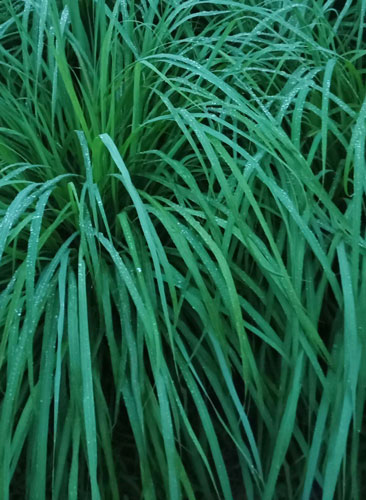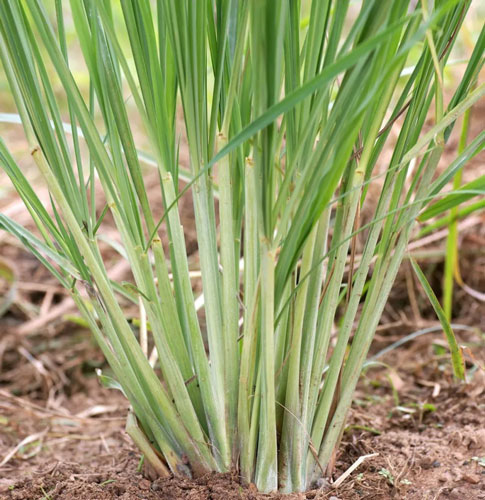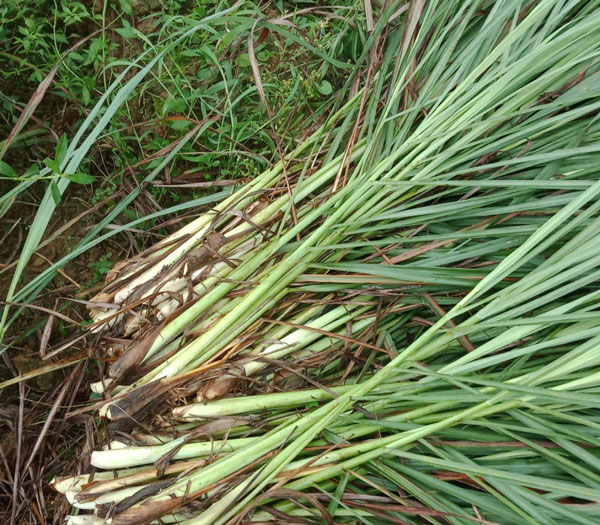Lemongrass (Cymbopogon Citratus) Care & Propagation Guide
Written by Iris
Oct 16 2021

Lemongrass (Cymbopogon Citratus) is a tropical crop produced in South and Southeast Asia. It is called lemongrass because of its strong lemon smell. The edible value of lemongrass is very wide. People often use it as an oil, as a spice, as a tea, and even as a bath.
To direct seed, wait until all danger of frost has passed. Choose a location with full sun and well-draining, nitrogen-rich soil. Plant individual seeds six inches apart.
Only put a sprinkling of soil over the seeds, as they need plenty of light to be able to germinate. Seedlings can take up to three weeks to emerge, and you’ll need to keep the soil moist during this period.
Once seedlings are a few inches tall, thin individual plants to two feet apart. You can transplant the seedlings you remove to another location if you wish.
If you are starting seeds indoors in seedling trays or containers, plant seeds one month before your predicted last frost date.
If you want to plant in pots, choose one that is at least one foot wide and one foot deep. Lemongrass does spread, so it can quickly fill up the whole container. With its habit of spreading quickly, if you don’t want it to take over your garden, growing in pots is a good way to keep it contained.
Fill containers with nutrient-dense soil and plant seeds six inches apart. Once seedlings are a few inches tall, thin single plants or clumps of plants to 1-2 feet apart.
To transplant seedlings, wait until they are at least three inches tall and all danger of frost has passed. Plant 2 feet apart with 2-3 feet in between rows.
If you don't have lemongrass plants in your garden, look for it in the produce section of your grocery store. This herb is commonly found in Asian markets.
Cut off the leaves and use them in your cooking, making sure that you’ve got a good 3-4 inches of stalk, to allow for successful root formation. Don’t cut off any of the bottom portion of the stem. If you do so, it’s unlikely to be able to form roots.
Next, to root your cutting, place it in a cup of water with the base of the stalk submerged. Change the water daily.
The plant will begin forming roots within a week. After 2-3 weeks, the roots will be large enough to support the plant.
At this point, transplant your lemongrass into well-aerated, nutrient-dense soil in a container or outdoors. Dig a 1/2-inch hole, place the cutting root side down, and backfill around the stem with soil. You should be able to start harvesting about 2-3 months after you've planted them out.
This herb is a clumping grass, meaning it grows multiple stalks from the base. These stalks can be divided and planted in a different location.
To divide, you'll need to gently separate some stalks from the main clump. One way to do this is to firmly grasp a stalk and pull it until it separates from the rest of the plant. If the roots are very twisted together and tangled, you may need to use a knife to carefully separate them, keeping some roots intact on each stalk for replanting.
Alternatively, you can dig up a whole plant and then separate the stalks with your hands or a knife.
Each division should contain at least one stalk with intact roots.
After separating, plant the divisions 1-2 feet apart in your desired location. Make sure this area has full sun as well as nutrient-dense and well-aerated soil.

As lemongrass grows, it forms a tight clump that's difficult to dig into. Use a sharp spade or hatchet to remove roots in early spring. Slice it like a pie, then pry slices of roots free. Keep an eye on plants in pots. With sufficient water, roots can quickly fill a too-small pot and burst it.
How to Grow Lemongrass (Cymbopogon Citratus)Grow Lemongrass from SeedGrow Lemongrass from CuttingsGrow Lemongrass from divisionHow to Care for LemongrassLemongrass Lighting RequirementsLemongrass Soil CareLemongrass WateringLemongrass Temperature & HumidityLemongrass FertilizerLemongrass PruningLemongrass Pests & DiseasesLemongrass Care FAQHow much sunlight does lemongrass need?Is Lemongrass an annual or a perennial?What should I do with Lemongrass during the winter?Can you freeze Lemongrass?
How to Grow Lemongrass (Cymbopogon Citratus)
You can grow lemongrass (Cymbopogon Citratus) from seed, from cuttings, or by division.Grow Lemongrass from Seed
If you choose to propagate lemongrass from seed, start in the spring.To direct seed, wait until all danger of frost has passed. Choose a location with full sun and well-draining, nitrogen-rich soil. Plant individual seeds six inches apart.
Only put a sprinkling of soil over the seeds, as they need plenty of light to be able to germinate. Seedlings can take up to three weeks to emerge, and you’ll need to keep the soil moist during this period.
Once seedlings are a few inches tall, thin individual plants to two feet apart. You can transplant the seedlings you remove to another location if you wish.
If you are starting seeds indoors in seedling trays or containers, plant seeds one month before your predicted last frost date.
If you want to plant in pots, choose one that is at least one foot wide and one foot deep. Lemongrass does spread, so it can quickly fill up the whole container. With its habit of spreading quickly, if you don’t want it to take over your garden, growing in pots is a good way to keep it contained.
Fill containers with nutrient-dense soil and plant seeds six inches apart. Once seedlings are a few inches tall, thin single plants or clumps of plants to 1-2 feet apart.
To transplant seedlings, wait until they are at least three inches tall and all danger of frost has passed. Plant 2 feet apart with 2-3 feet in between rows.
Grow Lemongrass from Cuttings
Cuttings taken from mature Lemongrass (Cymbopogon Citratus) can be rooted for later planting. To take a cutting, cut the stalk cleanly with a knife about an inch from the ground. This will allow the stalk left in the ground to regrow. Cut off the upper portion of the stalk, leaving only the bottom three to four inches.If you don't have lemongrass plants in your garden, look for it in the produce section of your grocery store. This herb is commonly found in Asian markets.
Cut off the leaves and use them in your cooking, making sure that you’ve got a good 3-4 inches of stalk, to allow for successful root formation. Don’t cut off any of the bottom portion of the stem. If you do so, it’s unlikely to be able to form roots.
Next, to root your cutting, place it in a cup of water with the base of the stalk submerged. Change the water daily.
The plant will begin forming roots within a week. After 2-3 weeks, the roots will be large enough to support the plant.
At this point, transplant your lemongrass into well-aerated, nutrient-dense soil in a container or outdoors. Dig a 1/2-inch hole, place the cutting root side down, and backfill around the stem with soil. You should be able to start harvesting about 2-3 months after you've planted them out.
Grow Lemongrass from division
The best time to divide mature lemongrass is in the spring.This herb is a clumping grass, meaning it grows multiple stalks from the base. These stalks can be divided and planted in a different location.
To divide, you'll need to gently separate some stalks from the main clump. One way to do this is to firmly grasp a stalk and pull it until it separates from the rest of the plant. If the roots are very twisted together and tangled, you may need to use a knife to carefully separate them, keeping some roots intact on each stalk for replanting.
Alternatively, you can dig up a whole plant and then separate the stalks with your hands or a knife.
Each division should contain at least one stalk with intact roots.
After separating, plant the divisions 1-2 feet apart in your desired location. Make sure this area has full sun as well as nutrient-dense and well-aerated soil.

How to Care for Lemongrass
Lemongrass Lighting Requirements
Lemongrass (Cymbopogon Citratus) is one of few that enjoy full, direct sun, so it's perfect to set in a bright sunny window or an unshaded area of your garden if you want to keep it outside. Lemon grass will need plenty of bright sunlight even in winter, so ensure it has access to natural light; otherwise, the stalks will turn brown. If situated in an ideal bright spot, you will see rapid growth during summer months from your lemon grass. If your plant lives in an area with bright but indirect light, it should still grow well, but not as quickly. Lemon grass does not like to be kept in low light or shaded areas and will suffer if it is kept in these conditions.Lemongrass Soil Care
As for the soil requirements, choose a well-drained soil (most any bagged soil mix) which will stay moist. A loamy soil ensures your citronella grass of getting what it needs. Soil which dry out will not work for growing a healthy Citronella plant!Lemongrass Watering
As a native of Southeastern Asia, Lemongrass (Cymbopogon Citratus) prefers hot, humid weather. It will thrive in many soil levels but can be killed when temperatures drop below 40 degrees Fahrenheit (4 C.). During the growing season, it is important to keep the plant hydrated regularly. How often should I water lemongrass? The answer is as easy as sticking your finger in the soil. If you have never grown lemongrass before, you may wonder about its care. Lemongrass plant watering is one of the most important aspects to growing healthy plants. These herbaceous grass-like plants can grow fast in hot weather and that rapid growth needs fuel. Lemongrass water requirements will vary dependent upon the type of soil you have. Sandy, loose soils will require more frequent watering, but those that are silty loam can retain moisture better and won't need to be irrigated as frequently. Additionally, the use of a layer of organic mulch can enhance soil water retention while also adding nutrients slowly to the soil.Lemongrass Temperature & Humidity
As tropical plants, Lemongrass (Cymbopogon Citratus) thrives in hot, steamy climates. The time for growing lemongrass outdoors is similar to the timing for tomato planting: when night temperatures are in the 60s, it's time to plant. Lemongrass is very frost sensitive, so if you plan to overwinter the plant indoors, bring it inside before temperatures get into the 40s.
Lemongrass Fertilizer
As a grassy plant, Lemongrass (Cymbopogon Citratus) needs a nitrogen-rich fertilizer for its best growth. You can use a slow-release 6-4-0 fertilizer that will feed lemongrass throughout the growing season. You can also water your lemongrass plants with manure tea, which will add trace nutrients.Lemongrass Pruning
Lemongrass (Cymbopogon Citratus) that live for more than one season benefit from an annual haircut to tidy up plants and remove dead foliage. Shear your plants to about 6 inches high at the end of winter, when plants are in their resting phase. Lemongrass plants will rebound quickly and send up new shoots when warm weather returns.Lemongrass Pests & Diseases
Few pests bother lemongrass. This herb is actually sometimes used in concoctions to repel insects. Occasionally, though, spider mites will attack plants overwintering indoors.As lemongrass grows, it forms a tight clump that's difficult to dig into. Use a sharp spade or hatchet to remove roots in early spring. Slice it like a pie, then pry slices of roots free. Keep an eye on plants in pots. With sufficient water, roots can quickly fill a too-small pot and burst it.

Lemongrass Care FAQ
How much sunlight does lemongrass need?
Lemon grass is a sun-loving plant, so whether you’re growing it outdoors in a garden or indoors in a pot, make sure you choose a place where it will receive plenty of bright, direct sunlight. This is an ideal plant for an unshaded area of your garden. In these conditions, lemon grass grows quite quickly. The plant will survive in an area with bright but indirect sunlight, but it’s growth will be slower.Is Lemongrass an annual or a perennial?
Lemon grass is a perennial, which means that it will regrow in the spring after being dormant throughout the fall and winter. However, because lemon grass is a tropical plant, it cannot survive in freezing temperatures. If you have lemon grass planted outdoors and live in an area that experiences frost and freezing temperatures during the winter, you will need to take special steps to keep your lemon grass alive during the winter by digging it up and bringing it indoors. Alternately, just replant in the spring.What should I do with Lemongrass during the winter?
Before the first frost, dig up a few stalks of your lemongrass plant, trim them to a few inches tall, and plant them in a small pot. You can store your plant in a cool, dark place like a basement, watering occasionally, letting the plant go dormant. If you would like to continue using your lemon grass throughout the winter, place the pot in a warm area with as much bright sunlight as possible, and keep the soil moist.Can you freeze Lemongrass?
Yes. If you harvest more lemongrass than you can use at one time, or just want to have some extra on hand, lemon grass freezes very well for up to six months. Trim the leaves and root ends, then place on a cookie sheet, evenly spaced so the stalks don't freeze together. Once the stalks are frozen, you can place them in a freezer-proof container for storage.Latest Updated
- Benefits of Bugleweed - 7 Science-backed Health Benefits
- Bugleweed Dangers & Side Effects - Is It Poisonous?
- How to Plant Evergreen Trees - What You Should Know
- When to Plant Evergreens - Grow Guide for Evergreen Trees
- 12 Wonderful Evergreen Shrubs for Your Garden
- 12 Popular Evergreen Plants with Pictures for Beginners
- When And How To Prune A Lilac Bush Like a Pro
- How to Grow & Care for Lilac Vine (Hardenbergia Violacea)
- Japanese Lilac Tree (Syringa Reticulata) Care & Propagation Guide
- Shumard Oak Pros and Cons - What to Know
Popular Articles
- Winter maintenance of Antirrhinum Majus
- How to Grow Terminalia Mantaly Tree
- How to Grow and Care for Crossostephium Chinense
- How to grow Antirrhinum Majus in spring
- Peristeria Elata (Dove Orchid) Profile: Info & Care Guide
- Underwatered Snake Plant (Sansevieria Trifasciata) - Signs And How To Fix
- How to Care for Brazilian Jasmine Plant (Mandevilla Sanderi)
- How to Grow & Care for Graptopetalum Purple Delight in Summer
- Rosa Chinensis (China Rose): Plant Growing & Care Tips
- How to Care for Baby Sun Rose (Aptenia Cordifolia)